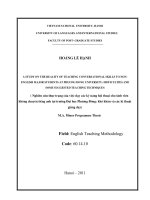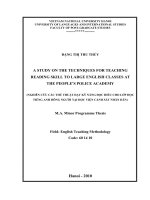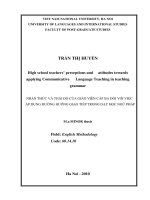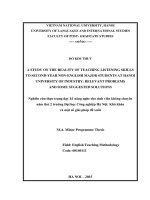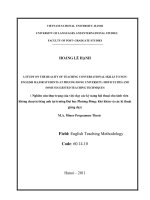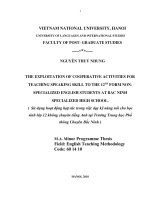Luận văn thạc sĩ high school EFL teachers perceptions about teaching learning strategies to EFL students
Bạn đang xem bản rút gọn của tài liệu. Xem và tải ngay bản đầy đủ của tài liệu tại đây (806.08 KB, 90 trang )
MINISTRY OF EDUCATION AND TRAINING
QUY NHON UNIVERSITY
NGUYEN THI NGOC CHAU
HIGH SCHOOL EFL TEACHERS’ PERCEPTIONS
ABOUT TEACHING LEARNING STRATEGIES TO
EFL STUDENTS
Field: Theory and Methodology of English Language Teaching
Code: 8140111
Supervisor: LE NHAN THANH, Ph.D
BỘ GIÁO DỤC VÀ ĐÀO TẠO
TRƢỜNG ĐẠI HỌC QUY NHƠN
NGUYỄN THỊ NGỌC CHÂU
NHẬN THỨC CỦA GIÁO VIÊN TIẾNG ANH THPT
VỀ VIỆC DẠY CHIẾN LƢỢC HỌC CHO HỌC SINH
Ngành: Lý luận và phƣơng pháp dạy học bộ môn tiếng Anh
Mã số: 8140111
Ngƣời hƣớng dẫn: TS. LÊ NHÂN THÀNH
i
DECLARATION OF AUTHORSHIP
The work contained in this thesis has not previously been submitted for
a degree or diploma in any university. I, the undersigned, certify that, to the
best of my knowledge and belief, my thesis contains no material previously
published or written by any other person except where due reference is made
in the thesis itself.
Binh Dinh, 2022
Nguyen Thi Ngoc Chau
ii
ACKNOWLEDGEMENTS
I would like to express the deepest appreciation to those who have
facilitated me to complete this paper.
First and foremost, my gratitude goes to my research supervisor, Dr. Le
Nhan Thanh, for his guidance, patience, and encouragement throughout my
study. His technical and editorial advice was essential to the completion of
this paper and has taught me innumerable lessons and insights on the
workings of academic research in general. I have been extremely lucky to
have a supervisor who cared so much about my work.
Secondly, I am indebted to all the teachers of the Department of English
for the useful knowledge that they taught me during the time I attended the
M.A course.
Importantly, I would also like to thank the participants at An Khe town
for their untiring supports to this research paper. Without their passionate
participation and input, the study could not have been successfully conducted.
Last but not least, I would like to express my special thanks to my family
members whose strong support and encouragement have kept me going this
far.
iii
ABSTRACT
Learning strategies are specific actions taken by the learner to make
learning easier, faster, more enjoyable, more self-directed, more effective, and
more transferable to new situations. Teaching learning strategies is very
necessary in learning process as it is used as a way to achieve a certain goal.
This study aimed to explore high school EFL teachers’ perceptions about
teaching learning strategies to their EFL students. The study focused on their
perceptions about the necessity, the benefits, and the difficulties of teaching
students how to learn English. The participants of the study included 40
teachers from nine high schools in a town in Gia Lai province. The
questionnaire was completed by forty high school teachers and the three semistructured interviews were carried out with participation of 3 high
school teachers chosen randomly. The data from the questionnaire was
analyzed by using Likert-type scale and regression linear statistical analysis
through IBM SPSS Statistics 22 Software, and the transcripts of the interview
were analyzed following content analysis to find answers to the research
questions. The findings of the study indicated that the teachers perceived that
teaching learning strategies had a positive impact on EFL students’ academic
performance and that these strategies were useful in their classrooms. Based
on the findings, implications are suggested for EFL teachers and educators to
enhance the effectiveness of English language teaching.
Key words: EFL, teaching learning strategies, teachers’ perceptions
iv
TABLE OF CONTENTS
DECLARATION OF AUTHORSHIP ............................................................... i
ACKNOWLEDGEMENTS .............................................................................. ii
ABSTRACT ..................................................................................................... iii
TABLE OF CONTENTS ................................................................................. iv
LIST OF ABBREVIATIONS ......................................................................... vii
LIST OF TABLES ......................................................................................... viii
LIST OF FIGURES.......................................................................................... ix
CHAPTER 1 INTRODUCTION .................................................................. 1
1.1 Rationale ................................................................................................. 1
1.2 Aim and Objectives of the Study ............................................................ 2
1.2.1 Aim of the study. .............................................................................. 2
1.2.2 Objectives of the study. .................................................................... 2
1.3 Research Questions ................................................................................. 3
1.4 Scope of the Study .................................................................................. 3
1.5 Significance of the Study ........................................................................ 4
1.6 Organization of the Study ....................................................................... 4
CHAPTER 2 LITERATURE REVIEW ...................................................... 6
2.1 Language Learning Strategies................................................................. 6
2.1.1 Definitions of language learning strategies. ..................................... 6
2.1.2 Features of language learning strategies. .......................................... 8
2.1.3 Classifications of language learning strategies. ................................ 8
2.1.3.1 Direct learning strategy. ........................................................... 10
2.1.3.2 Indirect learning strategies........................................................ 13
2.1.4 Four language skills. ....................................................................... 16
2.1.4.1 Listening skill. .......................................................................... 16
2.1.4.2 Speaking skill............................................................................ 16
2.1.4.3 Reading skill. ............................................................................ 16
v
2.1.4.4 Writing skill. ............................................................................. 17
2.1.5 Factors in strategy choice. .............................................................. 17
2.1.5.1 Learner factors. ......................................................................... 17
2.1.5.2 Situational and social factors. ................................................... 19
2.1.5.3 Academic factor. ....................................................................... 19
2.1.5.4 Cultural background. ................................................................ 20
2.2 Previous research related to the study and Gaps in the existing research
...................................................................................................................... 20
2.2.1 Previous research related to the study. ........................................... 20
2.2.2 Gaps in existing research. ............................................................... 23
2.3 Summary ............................................................................................... 23
CHAPTER 3 RESEARCH METHODOLOGY........................................ 24
3.1 Research Method................................................................................... 24
3.2 Participants ............................................................................................ 24
3.3 Instruments ............................................................................................ 25
3.3.1 The questionnaire. ........................................................................... 26
3.3.2 The interview. ................................................................................. 27
3.4 Data Collection ..................................................................................... 28
3.4.1 Administering the questionnaire. .................................................... 28
3.4.2 Administering the interview. .......................................................... 29
3.5 Data Analysis ........................................................................................ 30
3.6 Summary ............................................................................................... 31
CHAPTER 4 FINDINGS AND DISCUSSION ......................................... 32
4.1 Scale reliability Analysis ...................................................................... 32
4.2 High School EFL Teachers’ Perceptions in terms of the necessity of
teaching students how to learn English........................................................ 33
4.3 High School EFL Teachers’ Perceptions in terms of the benefits of
teaching students how to learn English........................................................ 39
vi
4.4 High School EFL Teachers’ Perceptions about difficulties in teaching
learning strategies ........................................................................................ 43
4.5 Summary ............................................................................................... 47
CHAPTER 5 CONCLUSION ..................................................................... 49
5.1 Conclusion ............................................................................................ 49
5.1.1 Research question 1. ....................................................................... 49
5.1.2 Research question 2. ....................................................................... 49
5.1.3 Research question 3. ....................................................................... 50
5.2 Limitations ............................................................................................ 50
5.3 Implications of the Study ...................................................................... 51
5.3.1 Implications for educators. ............................................................. 51
5.3.2 Implications for school administrators. .......................................... 51
5.3.3 Implications for teachers. ................................................................ 52
5.4 Recommendations for further research ................................................. 53
REFERENCES .............................................................................................. 55
APPENDICES
vii
LIST OF ABBREVIATIONS
ESL: English as second language
EFL: English as a foreign Language
LLSs: Language learning strategies
FL: Foreign language
viii
LIST OF TABLES
Table 2.1. Definitions of language learning strategies -Takač (2008:51)....... 7
Table 2.2. Features of language learning strategies - Oxford (1990:9) ............ 8
Table 2.3. Language Learning Strategy System (Oxford. 1990:17) ............... 10
Table 3.1. Participants’ background characteristics (Valizadeh, 2021) ......... 25
Table 4.1. Reliability Statistics of the questionnaire ..................................... 33
Table 4.2. EFL teachers’ perceptions about the necessity of teaching
learning strategies ......................................................................... 33
Table 4.3. EFL teachers’ perceptions about the necessity of teaching
learning strategies ......................................................................... 34
Table 4.4. EFL teachers’ perceptions about the importance of teaching
learning strategies ......................................................................... 35
Table 4.5. EFL teachers’ perceptions about the importance of teaching
learning strategies ......................................................................... 36
Table 4.6. Reasons for teaching learning strategies to EFL students ............. 37
Table 4.7. EFL teachers’ perceptions about the benefits of teaching
learning strategies ......................................................................... 39
Table 4.8. EFL teachers’ perceptions about the difficulties of teaching
learning strategies ......................................................................... 44
ix
LIST OF FIGURES
Figure 3.1. Quantitative data collection procedure ......................................... 28
Figure 3.2. Quantitative data collection procedure ......................................... 29
1
CHAPTER 1 INTRODUCTION
To set the scene for the study, this chapter starts with an overview of the use
of learning strategies in education in the world and Vietnam context. It then
describes the rationale for the study, the research aim and objectives, and the
research questions. This is followed by the scope and the significance of the
study. Finally, there is an overview of the organization of the study.
1.1 Rationale
Many nations in Asia and Europe have recently increased their efforts to
teach English as a second language (ESL) or as a foreign language (EFL) (ESL).
In recent years, second language education has shifted its emphasis away from
the ideal teaching strategy and toward how effective teachers and students
accomplish their objectives. Teachers' classroom study on the linguistic,
discursive, and interactional structure of educational events resulted from this in
their case. For students, this has resulted in research on (1) how individuals
approach learning both inside and outside of the classroom and (2) the different
types of methods and cognitive processes they employ when learning a second
language. One of the main purposes of educational evolution is to help students
learn how to learn more effectively. Teachers need to give students the
information, skills, and strategies they need to succeed.
When learning languages, some foreign language teachers may wonder
why some of their students are jumping ahead while others are slowly moving
forward, no matter how hard the teacher works to make the language lesson
interesting and fun. Part of this difference between more and less effective
language learners may be due to differences in ability, motivation, and/or
commitment. But an important factor seems to be the knowledge and ability
to use "how to learn" techniques or learning strategies. The purpose of using
learning strategies is to help students learn more efficiently (Weinstein &
2
Mayer, 1986). As students begin to understand their learning processes and
gain some control over those processes, they tend to take more responsibility
for their learning.
Chamot, Barnhardt, El-Dinary and Robbins (1999) noted: “The
differences between the most effective learners and the least effective learners
were found in the number and range of strategies used, in how the strategies
applied to the task, and whether they were appropriate to the task” (p. 166).
Therefore, teaching learning strategies is especially useful for later learners.
Learning strategies must be chosen according to the activity. Teachers can
teach certain strategies to their students, but these strategies do not always
work for them. The fact that teachers teach students optional strategies is
certainly an important factor and will affect their ability to be competent
English learners. As their learning styles differ, so do their preferred learning
strategies. If they find effective strategies for learning, they will be able to
study successfully.
In short, because of the importance of learning strategies, this research
aims to find out high school EFL teachers’ perceptions about teaching
learning strategies to EFL students. That is the reason why the research on
high school EFL teachers’ perceptions about teaching learning strategies to
EFL students was carried out.
1.2 Aim and Objectives of the Study
1.2.1 Aim of the study.
This study aims to explore high school EFL teachers’ perceptions about
teaching learning strategies to their EFL students.
1.2.2 Objectives of the study.
To achieve this aim, the researcher has tried to fulfill the following
objectives:
3
- to investigate high school EFL teachers’ perceptions about the
necessity of teaching students how to learn English,
- to explore high school EFL teachers’ perceptions about the advantages
in teaching students how to learn English, and
- to find out high school EFL teachers’ perceptions about the
disadvantages in teaching students how to learn English.
1.3 Research Questions
To achieve the above aim and objectives, the researcher has collected
data and analyzed it to answer the following questions:
1. What are high school EFL teachers’ perceptions about the necessity
of teaching students how to learn English?
2. What are high school EFL teachers’ perceptions about the advantages
of teaching students how to learn English?
3. What are high school EFL teachers’ perceptions about the
disadvantages of teaching students how to learn English?
1.4 Scope of the Study
In this part, the research mentions the scope of the time, the setting and
participants, the issues and the data.
The research will only be carried out in the academic year 2021–2022.
The research will be conducted at high schools in Gia Lai province with the
participation of 40 teachers of English.
There are many factors relating to the perceptions of teaching learning
strategies to EFL students such as the reasons, the importance, the effect, the
advantages and the disadvantages. But in this research, the researcher will
only focus on one issue: the importance of teaching learning strategies to EFL
students. There are two reasons for this choice: Firstly, due to the limitation of
4
time and ability, the research cannot cover all of the issues and problems. And
this problem is suitable for the reality of the teachers there so they can easily
have a complete understanding of these problems.
There are many ways to collect the data. The data can be collected by
questionnaires, narratives, interviews, observation and so on. In this study, the
researcher will use questionnaires and interviews to collect the data because
these ways are accessible and suitable for the teachers there and the researcher
can have qualitative and quantitative data with great reliability.
1.5 Significance of the Study
This study hopefully can give some contribution as follows:
The research should be seen as further contribution in understanding
about teaching learning strategies to EFL students. Moreover, this study will
give useful data related to teachers’ perceptions about teaching learning
strategies to EFL students. Findings and suggestions may be reasons for
further researches.
The findings of the research may help high school EFL teachers to know
the insights on teachers’ perceptions about teaching learning strategies to their
EFL students. Thanks to this, teachers can adjust and improve their teaching
methodology to help the students be able to know how to learn English.
1.6 Organization of the Study
There are five chapters in this study.
Chapter 1 – Introduction – presents the background information of the
study; including the rationale of the study, the aim and objectives, research
questions, scope of the study, the significance and organization of the study.
Chapter 2 – Literature review – provides the literature review with the
theoretical background of teaching learning strategies. In addition, previous
studies related to teaching learning strategies are also mentioned in this chapter.
5
Chapter 3 – Research methods and Procedures – discusses the
qualitative and quantitative methods employed in the study. Secondly, it
describes the participants of the study. Thirdly, it introduces the research
instruments, questionnaire and interview, used to collect data for the study.
Lastly, this chapter will come to an end with the procedure to conduct the
study and the methods of data analysis.
Chapter 4 – Findings and Discussion – analyzes, describes and
illustrates the EFL teachers’ perceptions about teaching learning strategies to
their EFL students. The information collected from the questionnaire and the
data of the semi-structured interviews will be analyzed in order to give more
explanations for the findings of the study. From these analyses, the results
from the analysis will be discussed.
Chapter 5 – Conclusion and Implications – summarizes the main points
of the study and suggests some implications for the learners and teachers
in teaching learning strategies as well as for further studies. Some limitations
are also presented in this chapter.
6
CHAPTER 2 LITERATURE REVIEW
This chapter will cover the two main parts: theoretical framework and
prior empirical studies. The former looks at the general background of
language learning strategies. The latter reviews some related empirical studies
examining learning strategies around the world and in Vietnam.
2.1 Language Learning Strategies
Language learning strategies play an essential role in teaching and
learning English since they facilitate learners' enhancement, which is very
useful for learners' competence.
2.1.1 Definitions of language learning strategies.
Different linguistic researchers define language learning strategies
(LLSs) in different ways. The term "language learning strategies" is defined
in various ways such as "technique", "tactic" and "skill". These definitions
sometimes overlap and conflict with each other. Weinstein and Mayer (1986)
claim that LLSs relate to both behaviors and thoughts, which are invisible.
Therefore, Weinstein and Mayer (1986) state that "LLSs are known as
particular behaviors and thought processes used by the learners to facilitate
acquisition, storage, or retrieval of information" (p.315). In contrast, Oxford
and Aphek (1989) define the term as "behaviors" or "actions", which are
easily visible. Simply, Nunan (1991, p.168) defines "LLSs are the mental
processes which learners adopt to learn and use the target language". As such,
Nunan's definition limits learning strategies as "mental processes".
Oxford (1998) states that LLSs are the purposeful mental methods
adopted by the learners to approach of the target language. Similarly, Takac
(2008) defines LLSs are learners' effortfulness to learn a second language. He
also collects some more definitions of the different scholars.
7
Table 2.1. Definitions of language learning strategies -Takač (2008:51)
Source
Definition
Tarone (1981)
An effortfulness to develop linguistic and sociolinguistic
competence in the target language.
Weinstein and
Mayer (1986)
Chamot (1987)
Behaviors and thoughts that a learner engages in during learning
that are intended to influence the learner’s encoding process.
Techniques, approaches or deliberate actions that students take in
order to facilitate learning, recall of both linguistic and content
information.
The term refers to language behaviors learners engage in to learn
and regulate the learning of L2, to what learners know about the
strategies they use (i.e. strategic knowledge), and to what learner
know about aspects of L2 learning.
What learners do to learn and do to regulate their learning.
Generally, a strategy is a mental or behavioral activity related to
some specific stage in the process of language acquisition or
language use.
Broadly speaking, the term strategy denotes procedures which are
sometimes conscious and sometimes unconscious used by a person as a
way of reaching a goal.
Behaviors or actions which learners use to make language learning
more successful, self-directed and enjoyable.
Processes which are consciously selected by learners and which
may result in action taken to enhance the learning or use of a L2,
through the storage, recall and application of information about
that language.
Conscious or unconscious techniques or activities that an
individual invokes in language learning, use or testing.
Wenden (1987)
Rubin (1987)
Ellis (1995)
Ridley (1997)
Oxford (1998)
Cohen (1998)
Purpura (1999)
It seems that the researchers agree that LLSs as “techniques” employed
by the learners to gain knowledge of the target language. Although they
attempt to clarify the definitions of LLSs in different ways, these concepts of
LLSs, which are still general, vague, and unclear, some arguments over the
concept of LLSs in a particular perspective, altogether they agree with Liang
(2009) about what LLSs are either behavioral, and thus visible, or mental, and
thus invisible or LLS are learning methods including broad approaches as
well as particular actions or techniques for learning a foreign language (FL).
8
2.1.2 Features of language learning strategies.
It is argued that the best ways to define the notion of LLSs is to list the
central characteristic of LLSs. Oxford (1990) provides an adequate list feature
of language learning strategies.
Table 2.2. Features of language learning strategies - Oxford (1990:9)
Features of language learning strategies
1. Contribute to the main goal, communicative competence.
2. Allow learners to be more self-directed.
3. Expand the role of the teacher.
4. Are problem-oriented.
5. Are specific action taken by learner
6. Involve many aspects of the learner, not just the cognitive.
7. Support learning both directly and indirectly
8. Are not always observable.
9. Are often conscious.
10. Are flexible.
11. Are influenced by a variety of factors.
2.1.3 Classifications of language learning strategies.
As specified in the above definitions, LLSs are divided into different
categories by various researchers such as Weinstein and Mayer (1986),
Oxford and Aphek (1989), Nunan (1991).
The classification of LLSs is logically developed through time. The
early categorization which attempted to recognize and define the behavior of
“language learners”. Basing on language learning process, LLSs are divided
into four categories. The first category is formal language practicing (which
refers to knowledge about language related to grammatical and syntactical
elements (i.e., “the language code”), the second category is functional
practicing or using language for “authentic communication purposes”, the
third category is monitoring for examining and modifying or correcting
linguistic output, and the last category is inferencing used for guessing a
9
previously unknown meaning or form in a second language (Bialystok 1978,
p. 78-80)
Wong-Fillmore (1979) also looking into the role of the individual in
language learning divides LLSs into “cognitive” and “social” LLSs, while
Rubin (1981), relying on learners’ actions, classifies LLSs into “indirect” and
“direct” LLSs.
The earlier classification of LLSs (Bialystok, 1978; Wong-Fillmore,
1979; Rubin, 1981) concentrates on providing the whole picture of LLSs
employed by the learners while the later categorization of LLSs by O’Malley,
Chamot, Stewner-Manzanares, Russo, and Küpper (1985), depending on
“learners’ mental process,” divides LLSs into cognitive, metacognitive and
socio-affective strategies.
Oxford (1992) claims that LLSs fall into five categories, the first
categories are those referring to the behaviors of successful language learners;
the next ones are those based on psychological functions (cognitive,
metacognitive and affective); the following ones are those based on language
aspects (e.g. monitoring); the later ones are those relied on language skills or
knowledge (e.g., oral production, vocabulary learning); and the last ones are
those relied on different learning types or styles.
According to Oxford (1990, p.16), direct learning strategy is divided
into
three
secondary
strategies,
namely:
memory,
cognitive,
and
compensation strategies. While Oxford categorizes Indirect learning strategy
into metacognitive, affective, and social strategies as presented in the
following table.
10
Table 2.3. Language Learning Strategy System (Oxford. 1990:17)
Type
Primary Strategies
1. Memory strategies
Direct
Strategies
2. Cognitive
strategies
3. Compensation
strategies
1. Metacognitive
strategies
Indirect
Strategies
2. Affective
strategies
3. Social strategies
Secondary Strategies
A. Created mental linkages
B. Applying images and
sounds
C. Reviewing well
D. Employing action
A. Practicing
B. Receiving and sending
messages
C. Analyzing and reasoning
D. Creating structure for
input and output
A. Guessing intelligently
B. Overcoming limitations
in speaking and writing
C. Centering your learning
A. Centering your learning
B. Arranging and planning
your learning
C. Evaluating your learning
A. Lowering your anxiety
B. Encouraging yourself
C. Taking your emotional
temperature
A. Asking question
B. Cooperating with others
C. empathizing with others
2.1.3.1 Direct learning strategy.
Oxford (1990:37) characterizes direct learning strategy as language
learning strategy that involves directly the target of the learning. As shown in
the table above, Memory strategies, Cognitive strategies, and Compensation
strategies are defined as direct learning strategies by Oxford.
“Memory strategies, such as grouping or using imagery, have a highly
specific function helping students store and retrieve new information.
Cognitive strategies, such as summarizing or reasoning deductively, enable
learners to understand and produce new language by many different means.
11
Compensation strategies, like guessing or using synonyms, allow learners to
use the language despite their often large gaps in knowledge” (p.37). Memory
Strategy has some secondary strategies as follows.
a. Creating mental linkages.
There are three useful strategies for receiving, remembering, and
retrieving new knowledge associating/collaborating, grouping, and placing
new vocabularies into a context to make mental linkages.
b. Applying images and sounds.
To remember new expressions that the students get from listening or
reading, they can use four strategies such as using imagery, semantic
mapping, using keywords, and representing sounds in memory.
c. Reviewing well.
Reviewing well strategy is especially considered to be useful for
remembering new material in the target language. It requires reviewing at different
intervals, the intervals at first close together and then increasingly far apart.
d. Employing action.
In employing action strategy, the two strategies like physical response
or sensation and mechanical techniques are used.
e. Using memory strategies for retrieval.
Memory strategies can be used by students or learners to recall target
language information faster, as this information can be used for
communication involving all four language skills. The same mechanism that
was originally used to memorize the new information (e.g. a mental
association) can then be used to retrieve information. By thinking of the
student's original image, the combination of sound and image, action,
sensation, association or grouping, one can quickly remember what is needed.
Information, especially if the learner has taken the time to go through the
12
material in a structured way after the first encounter. Cognitive Strategies
consist of practicing, receiving and sending messages, analyzing and
reasoning, and creating structure for input and output are four sets of
cognitive strategies that useful for language learners. The secondary strategies
of the cognitive strategy include:
a. Practicing.
The first and the most important cognitive strategies’ set is practicing
which involves five strategies: repeating, usually practicing with sounds and
writing systems, recognizing and using formulas and patterns, recombining,
and practicing naturalistically.
b. Receiving and sending messages.
Two strategies: getting the idea quickly and using resources for
receiving and sending messages are the components of receiving and sending
messages.
c. Analyzing and reasoning.
Analyzing and reasoning consists of five strategies that help learners to
understand and use the grammar rules and vocabulary by using their own
logical thinking. These strategies are useful, but they can cause problems if it
is used in over.
d. Creating structure for input and output.
All four skills can be aided by creating structure for input and output
strategy, and it contains three strategies: take notes, summarize, and
highlighting. Learners can use these three strategies to sort and organize the
target language information. Moreover, these strategies allow students to
prepare for using the language for speaking and writing and demonstrate their
understanding tangibly. Compensation Strategies:
Learners can overcome knowledge limitations in their four skills by using
13
the compensation strategies. These strategies may play an important role in
helping beginners and intermediate language students, also for expert language
users who do not know an expression in some conditions, who fail to hear
something clearly or who are confused with implicit or intentionally vague about
the meaning. The secondary strategies of compensation strategies are:
a. Guessing intelligently in listening and reading.
One of the important techniques for listening and reading is guessing. It
aids learners to recognize and understand every single word before
comprehending the overall meaning. A lot of language can actually be
understood through systematic guessing, without necessarily comprehending
all the details. Using linguistic clues and other clues are two compensation
strategies relevant to listening and reading.
b. Overcoming limitations in speaking and writing.
Contributing to learning are all the compensation strategies for speaking
and writing. It allows learners to stay in conversations or keep writing long
enough to get sustained practice also provide New knowledge is also provided
in a more obvious way by some of these strategies (e.g., getting help).
2.1.3.2 Indirect learning strategies.
Indirect learning strategies are the second category of learning
strategies, as defined in Oxford (1990:135). Indirect learning strategies are
strategies that support and manage language learning without directly
involving the target of the language. The direct learning strategies directly
involve the language that learners learn, but indirect learning strategies do not
involve the language that learned. Indirect learning strategies give support
through focusing, planning, seeking opportunities, evaluating, controlling
anxiety, increasing cooperating and empathy and other means for language
learners learning. The parts of indirect learning strategies contain:
14
Metacognitive Strategies: students or learners get useful help from the
three sets of metacognitive strategies in increasing their language four skills,
that is: centering, arranging, planning, and evaluating Your Learning. The
secondary strategies are:
a. Centering your learning.
It is very important to find a focus or center for learning in all fourlanguage skills. Language learners face only confusion and noise without the
right strategies for centering.
b. Arranging and planning your learning.
There are six useful and helpful strategies for arranging and planning
students learning process in developing all language skills. These strategies
help learners discover the nature of language learning organize to learn,
establish aims, consider task purposes, plan for tasks, and look for
opportunities to practice.
c. Evaluating your learning.
There are two strategies related to monitoring one's own errors and
evaluating one's overall progress can be used to evaluate your learning
strategy that useful in language four skill areas.
Affective Strategies include lowering your anxiety, encouraging
yourself, and taking your emotional temperature are the three sets of affective
strategies. Three of them are applied to various language skills and are
explained below.
a. Lowering your anxiety.
Some learners not only encounters great anxiety in speaking the new
language but they also experience tremendous anxiety when listening,
reading, or writing. Students can get help to lower their anxiety by the
following strategies, no matter which skill is involved.
